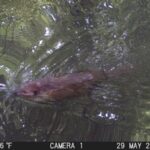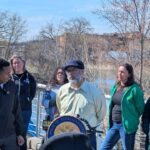One of the Bronx River’s vanished freshwater wetlands was the Bear Swamp.Draining into the Bronx River about where the Bronx Zoo’s Boston Road entrance is today, it covered over 180 acres east of White Plains Road in the present-day Bronxdale and Van Nest neighborhoods.Bronxdale Avenue follows the line of the old Bear Swamp Road that ran through this marshy area. There may have been a Native American settlement there at one time: in the early 1800s a basin for grinding corn was found cut into a rock outcrop.
About the only trace of the Bear Swamp you can see today is a gentle dip in the terrain east of White Plains Road. The original Siwanoy name for the place appears to have been forgotten, but the early colonists called it “Bear Swamp” for good reason.The swamp was a productive hunting ground, and among the animals hunted there were Black Bears, whom the Siwanoy trapped by driving them between converging wooden palisades.
Bears were an important part of the Native American economy.Their teeth and claws were decorations a hunter could wear with pride, and their hides made wonderfully warm robes and blankets.The meat was tasty and nutritious, and their fat, boiled down, was used as hair dressing, or served as an insect repellant handy for your next foray into the bug-ridden Bear Swamp.
The name of the Bear Swamp Road persisted until about World War One, when it was straightened out and renamed Bronxdale Avenue.By that time bears were long gone from the banks of the Bronx River, and, with railroads and an elevated train line serving the area, the filled-in swamp was attracting the attention of real-estate developers, including a “Bear Swamp Realty Company.”
Stephen Paul DeVillo





